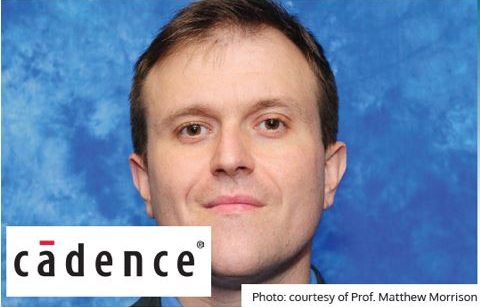His solution, developed in collaboration with CAD software developer Cadence and CMC Microsystems, may mark a turning point in how the world educates and trains coming generations of innovators.
“We need people qualified to drive those innovations, and that means finding ways to improve access to hardware education,” says Morrison, Assistant Teaching Professor in UND’s Department of Computer Science and Engineering whose research includes low-power hardware security, VLSI design, and smart health technologies. “It’s where the need for growth is greatest.”
So last year, with that need in mind, he began developing a high-level synthesis course for undergraduates. “The idea of the class was to use higher level programming to do lower-level computer chip design, reducing the time it takes to synthesize a chip.”
But Morrison faced a significant challenge. The sophisticated Cadence software tools and powerful server capacity needed to offer the course required costly expertise to set up and run, and students, many of whom were juggling part-time jobs and school, couldn’t access those resources off-campus.
Coincidentally, earlier that same year Cadence had approached CMC Microsystems, a longtime facilitator of Cadence tools for Canadian universities, about using the public cloud to provide similar services to the company’s academic clients in the U.S. So when Morrison came to Cadence with his access problem, they connected him with CMC’s Owain Jones, Manager of its CAD Business Unit, to help him address the issue.
‘421 undergraduate, graduate and doctoral students from 94 universities across 20 countries logged into the two-week course’
Morrison and CMC, with Cadence’s blessing, decided to pilot their solution. “It was a huge challenge for the three partners,” Morrison says. “It took about a year, and a lot of trial and error, but we developed a good framework and set of directions, so that students could log in simply and use the tools, while ensuring the arrangement met all of the partners’ legal requirements.”
Their project was 95 percent complete when the pandemic hit, leaving faculty scrambling to adapt their courses to remote learning. ”It was a massive stress test of internet capability across the country,” Morrison says. “But for us, given the work we’d already done, the course transitioned quite smoothly. We were able to get started with everything immediately.”
Working remotely, students were able to complete their final project, developing an artificial intelligence network for pattern and image recognition — an ambitious project made only possible because of the novel cloud solution developed by CMC, Cadence, and Morrison.
Sensing its potential, the collaborators went on to stress-test their distance learning prototype on a vastly broader stage, when Morrison offered his high-level synthesis tutorial at the DAC (Design Automation Conference) Summer School in July 2020. Normally offered onsite by Cadence to only 20 or 30 students, the virtual format enabled Cadence and CMC to expand its reach. The response was overwhelming: 421 undergraduate, graduate and doctoral students from 94 universities across 20 countries logged into the two-week course, and more than 200 completed their projects.
“It’s the most extensive work anyone’s been able to do in this area, because we could do it virtually. Normally you never have more than 20 students in this kind of class,” Morrison says. “It wouldn’t have been possible without CMC. They set up the infrastructure and provided tech support throughout the process.”
The potential impact on academic learning and training is profound, the collaborators say. “The public cloud allows access for students, wherever they are,” says Jones. “And for universities without those critical IT resources and technical support, it lowers the barriers to accessing these high-end tools. It’s a viable distance training option for universities everywhere who are grappling with this problem.”
For Morrison, a recipient of multiple teaching awards, the benefits to students are the greatest reward. “This is a game-changer,” says Morrison.” We now have the infrastructure, rapidly deployed, and a set of steps that can be set up in any classroom, anywhere in the world.”
Photo Credit: Courtesy of Prof. Matthew Morrison
November 2020

